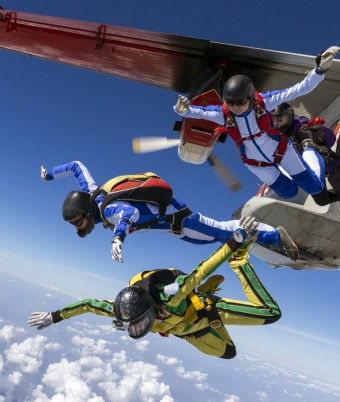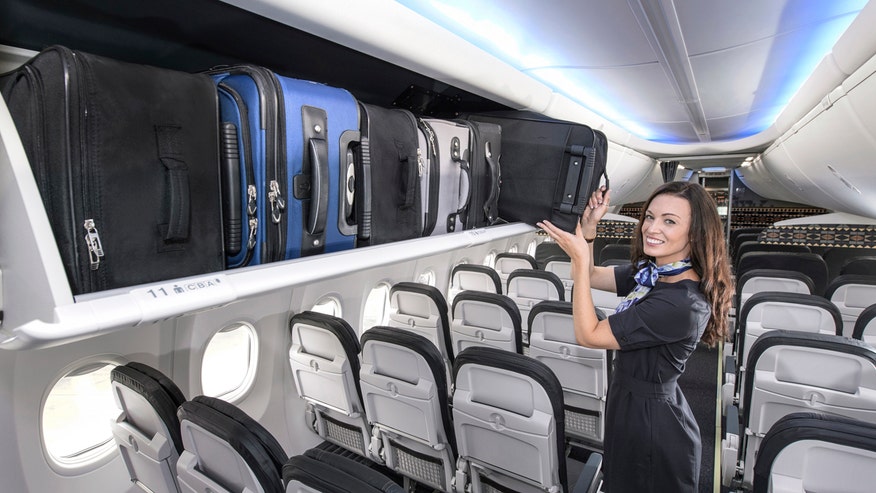
The galley isn’t for yoga. Picture: PassengerShaming.com Source: Facebook
SURE, it’s uncomfortable being jammed into an airline seat the width of a pizza box (if you’re lucky) for hours on end, listening to the shriek of babies and engaging in elbow wars with your seat-mate while you try to shove down food that tastes like feet.
But that’s the reality of flying these days, you didn’t score that $199 flight without making some sacrifices.
So just remember that for you it’s a temporary descent into hell. But for the flight attendants helping you out, it’s their everyday reality.
Perhaps you wonder how to make their job a bit less painful? Here’s a list of the things that flight attendants really wish passengers would stop doing.
• Leaving rubbish in the pocket on the back of the seat
“We walk up and down the aisle throughout the flight with a trash bag to collect trash.” — Abbie Unger, flight attendant, author and founder of the Flight Attendant Career Connection.

Nappies, socks and rubbish. Picture: PassengerShaming.com Source: Facebook
• Taking ages to decide what you want to drink. And having bad timing
“You’ve seen me walking down the aisle with the drink cart for 20 minutes already.” — Facebook user Corinne Spring from the Flight Attendant Career Connection.
• “There is nothing more irritating than when a passenger comes straight onto the plane and asks for a soft drink. I’m like, ‘Seriously?’” — Nick Stracener, a flight attendant with American.
• Being a space hog
“My head literally just exploded. #TheSenseofEntitlement.” — Shawn Kathleen, who runs the blog PassengerShaming said of the below photo showing items such as heels and a hat taking up precious overhead space.

Got enough room? Picture: PassengerShaming.com Source: Facebook
• Poking or grabbing me
“Please don’t touch, poke, or tug on a flight attendant. You could say ‘ma’am’ or ‘sir’. You can say ‘miss,’ ‘excuse me,’ ‘pardon me’ — or just wait until I make eye contact with you. But please don’t touch my rear end again!” — Abbie Unger.
• Blocking the aisle
“Attention all passengers: Stop. Doing. This.” — Shawn Kathleen said of the photo below showing passengers sharing earphones across the aisle.

Please be considerate. Picture: PassengerShaming.com Source: Facebook
• Making yourself at home, including clipping your nails and walking to the bathroom barefoot
“It’s just so gross. And people in first class are even worse — they think it’s their house.” — Nick Stracener.
“We are always reminding people to put their shoes on because the wetness on the floor is not water.” — Sydney Pearl, author and creator of the website Diary of a Pissed Off Flight Attendant.

Eww. Picture: PassengerShaming.com Source: Facebook
• Using the toilet when the plane is about to land — or meals are being served
“My main pet peeve is when people get on the plane and immediately go to the bathroom all the way in the back.” — an anonymous flight attendant told theNYPost.
• Hanging out in or near the galley
“I came out of the galley and she scared the crap out of me!!” — Shawn Kathleen said on spotting the woman in the photo below in such a strange place, and position.

What’s she doing there? Picture: PassengerShaming.com Source: Facebook
Source….www.news.com.au
Natarajan

![Bulgaria Air, Bulgaria: Customer rating 6/10. "It seemed that the best I could get from them [the crew] was ignorance".](http://www.traveller.com.au/content/dam/images/g/j/8/4/j/h/image.imgtype.thumbnail.100x66.png/1440564585855.jpg)








 JustJ100 years ago, getting from America to Europe was a voyage that took several days by ocean liners. With the invention of airplanes, that travel time was significantly shortened to under 24 hours. At the apex of the era of transatlantic flight, the Concorde was able to fly 100 passengers at Mach 2.0 speeds from New York to London in just over 3.5 hours.
JustJ100 years ago, getting from America to Europe was a voyage that took several days by ocean liners. With the invention of airplanes, that travel time was significantly shortened to under 24 hours. At the apex of the era of transatlantic flight, the Concorde was able to fly 100 passengers at Mach 2.0 speeds from New York to London in just over 3.5 hours.
































































